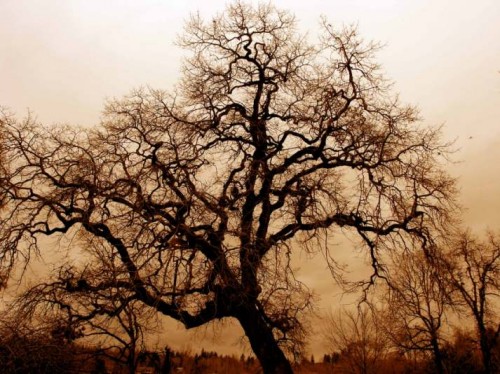|
OAK >> Sensual Goods and Truths of the Church
 The oak would seem to belong with peculiar appropriateness to the people of an Iron Age. More than any other family of trees it seems to answer in the vegetable kingdom to the iron of the mineral. “Strong as an oak” and “tough as an oak” are common expressions which are entirely justified by the character of the tree. The oak would seem to belong with peculiar appropriateness to the people of an Iron Age. More than any other family of trees it seems to answer in the vegetable kingdom to the iron of the mineral. “Strong as an oak” and “tough as an oak” are common expressions which are entirely justified by the character of the tree.
The main root of the oak, where the soil is favorable, descends to a great depth compared with its height, especially in young trees, and it stretches to a distance horizontally—and that at a considerable depth—equal to the spread of the branches; thus taking a stronger hold of the earth than any other tree of the forest. It does not often tower upwards to so magnificent a height as many other trees; but, when standing alone, it throws out its mighty arms with an air of force and grandeur which has made it everywhere to be considered the fittest emblem of strength and power of resistance. (See the article, under “Chestnuts.”)
The great value of the oak, in all countries, is for its wood. It is applied to a greater variety of important purposes than that of any other tree. . . . For strength, hardness, toughness, and durableness united, it is unsurpassed; although each of these properties singly is found to a greater degree in some other wood.” (Emerson’s Trees and Shrubs of Massachusetts, pp. 137, 138) The first knowledge of good and evil, right and wrong which a child has, is not an interior, rational knowledge, but a knowledge of the statements and teachings which are the results of thought. There is such a thing as thinking rationally from a knowledge of the Divine standards of right, and, from that rational thought, deducing rules or formulas of speech and action, relating to practical questions of every kind. A child’s first knowledge is a knowledge of such formulas, not thought out rationally by him, but learned from others with a child’s intelligence, and held with great tenacity and stiffness, because they are the strength of his life. When Abram first entered the land of Canaan, he dwelt in the oak grove of Moreh; and afterwards in the oak grove of Mamre. And this Swedenborg interprets as meaning that when the Lord departed from the natural states into which He was born, and began to learn of Divine and heavenly states, His first knowledge was of this childlike kind. The things first learned are like oaks, he says, “on account of the intertwined branches of the oak” (Arcana Coelestia #1443). They are like oaks also in the strength and tenacity with which they are held. And their fruits, or the works done from such knowledge of right and wrong, are like the somewhat bitter, but not innutritious, acorns.
It is interesting to note the affinity which the acid of oak galls and oak bark has for iron. The acid of the oak must represent a zeal for formulating, or for fixing and remembering in set forms; for the whole tree represents a knowledge of and a love for such forms. Iron is the representative of ultimate truth in which all life rests. This the zeal for formulating seizes upon as the very means of making knowledge fixed and definite; as the oak acid unites with the iron to make ink, with which all knowledge is written down in fixed and enduring forms.
The acid of oak bark unites in the same way with the skins of animals, to make leather. For the skins of animals represent the usual manifestations and descriptions of the natural affections; of which the zeal for formulating makes a clothing of manners, according to the customs of the world, fitted to bear hard knocks, and to conceal and protect the sensitive feelings within it. The Divine Truth in the lowest form of definite laws and customs is as it is usually presented in the Old Testament, and as it was revealed by living voice from Mount Sinai to the Israelites. This was the character of the Dispensation of which the Israelites constituted the center. In the circumferences of the Dispensation, accordingly, among the Gentile nations, oracles were established in oak groves, where men inquired the will of the gods, and where no doubt they received instruction from the spiritual world, adapted to their state. Zeus, the great god of the Greeks, we are told, “at Dodona in Epirus, revealed his will towards men, and the incidents of their future life, in the rustling of the branches of a holy oak” (Murray, p. 48). “The oak and the olive, of all the trees of the earth, . . . were most sacred to him” (p. 50); the olive because it represented perceptions of the love of God in the inmost of the mind, and the oak because it represented the perception of His will in ultimates. Therefore, also, “as god of Dodona, he wears a wreath of oak leaves, and as Olympic god, a wreath of the sacred olive of Olympia” (p. 51).
Author: JOHN WORCESTER 1875
|
|